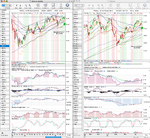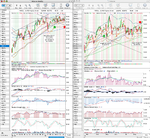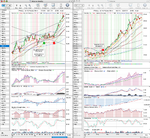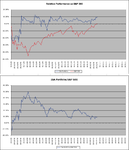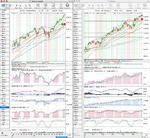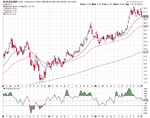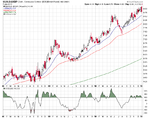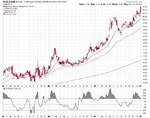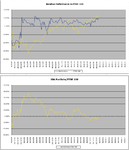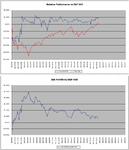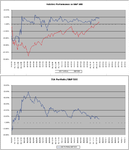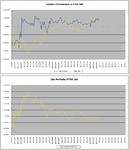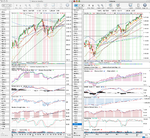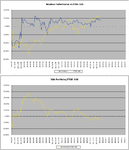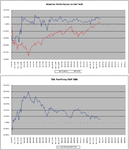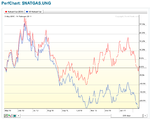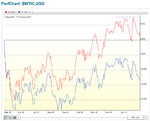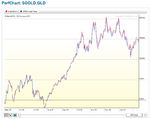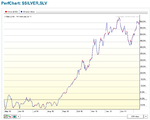isatrader
Senior member
- Messages
- 2,964
- Likes
- 135
2010 Trades Review
I’ve been working hard on learning point and figure charts the last few days and another trader from this site has been helping me with it and he manually built a one hour GBP/USD P&F chart from scratch and I’ve been updating it and trying to learn as I do. Point and figure is something that I think will be very useful for my long term trading once I get the hang of it. Anyway that’s slowed down my trades review. Am up to number eight for the year; so half way through now.
This next trade was a scale in into my previous silver trade which had been open for a month and was moving up after retesting the downtrend line support.
Trade No 48
Ticker: PHAG (ETFS Physical Silver)
Entry
Entry Date: 27/4/10
Offer Price: £11.95 ($18.01 @ FX rate 1.5070)
Amount: 83 Shares
Entry Commission: £7.00
Stamp Duty: £0.00
Total: £998.75
rValue Zone: Above
Entry Grade: 46% of days range
Entry Analysis – see 1st chart
Price has broken out of the downtrend and retested the downtrend support line. Is now looking to make a new weekly closing high for the year. Technicals aren’t showing any divergences and have room to the upside. The entry point looks good from the chart. My entry grade was only 46% of the days range, so could have been better.
Exit
Exit Date: 26/8/10
Bid Price: £12.04 ($18.72 @ FX rate 1.5547)
Amount: 83 Shares
Exit Commission: £0.00
Total: £999.39
Profit/Loss: £0.64
Percentage Gain/Loss: 0.06% (3.23% in dollars)
Exit Grade: 0.08% of days range
Daily Keltner Channel Captured: 11%
Trade Grade: C
Exit Analysis – see 2nd chart
The price topped a few weeks after I bought and fell into a range between $17 and $19 for four months. Price action was choppy with frequent violent down days which made me nervous of the position. I decided to exit when the price made a sharp move up for a few days near the end of August as silver looked to be forming a 2 year double top pattern. So I closed the trade.
Follow up Analysis – see 3rd chart
As you can see from the follow-up chart. The day I sold was basically the beginning of silvers huge rally that continues today. Holding the position would have produced around a 66% gain, but I managed to get a whopping 0.06% of that. Is even more stupid when I look back on it now as September is usually such a great month for silver and I always aim to have a position on before September starts.
Lessons from this trade
Stick to the plan. Generally, I should to use the weekly safezone stop loss as my guide to look for an exit point on these trades. Instead I used the if in doubt get out method. A very bad trade.
The charts of the trade are attached below.
I’ve been working hard on learning point and figure charts the last few days and another trader from this site has been helping me with it and he manually built a one hour GBP/USD P&F chart from scratch and I’ve been updating it and trying to learn as I do. Point and figure is something that I think will be very useful for my long term trading once I get the hang of it. Anyway that’s slowed down my trades review. Am up to number eight for the year; so half way through now.
This next trade was a scale in into my previous silver trade which had been open for a month and was moving up after retesting the downtrend line support.
Trade No 48
Ticker: PHAG (ETFS Physical Silver)
Entry
Entry Date: 27/4/10
Offer Price: £11.95 ($18.01 @ FX rate 1.5070)
Amount: 83 Shares
Entry Commission: £7.00
Stamp Duty: £0.00
Total: £998.75
rValue Zone: Above
Entry Grade: 46% of days range
Entry Analysis – see 1st chart
Price has broken out of the downtrend and retested the downtrend support line. Is now looking to make a new weekly closing high for the year. Technicals aren’t showing any divergences and have room to the upside. The entry point looks good from the chart. My entry grade was only 46% of the days range, so could have been better.
Exit
Exit Date: 26/8/10
Bid Price: £12.04 ($18.72 @ FX rate 1.5547)
Amount: 83 Shares
Exit Commission: £0.00
Total: £999.39
Profit/Loss: £0.64
Percentage Gain/Loss: 0.06% (3.23% in dollars)
Exit Grade: 0.08% of days range
Daily Keltner Channel Captured: 11%
Trade Grade: C
Exit Analysis – see 2nd chart
The price topped a few weeks after I bought and fell into a range between $17 and $19 for four months. Price action was choppy with frequent violent down days which made me nervous of the position. I decided to exit when the price made a sharp move up for a few days near the end of August as silver looked to be forming a 2 year double top pattern. So I closed the trade.
Follow up Analysis – see 3rd chart
As you can see from the follow-up chart. The day I sold was basically the beginning of silvers huge rally that continues today. Holding the position would have produced around a 66% gain, but I managed to get a whopping 0.06% of that. Is even more stupid when I look back on it now as September is usually such a great month for silver and I always aim to have a position on before September starts.
Lessons from this trade
Stick to the plan. Generally, I should to use the weekly safezone stop loss as my guide to look for an exit point on these trades. Instead I used the if in doubt get out method. A very bad trade.
The charts of the trade are attached below.

